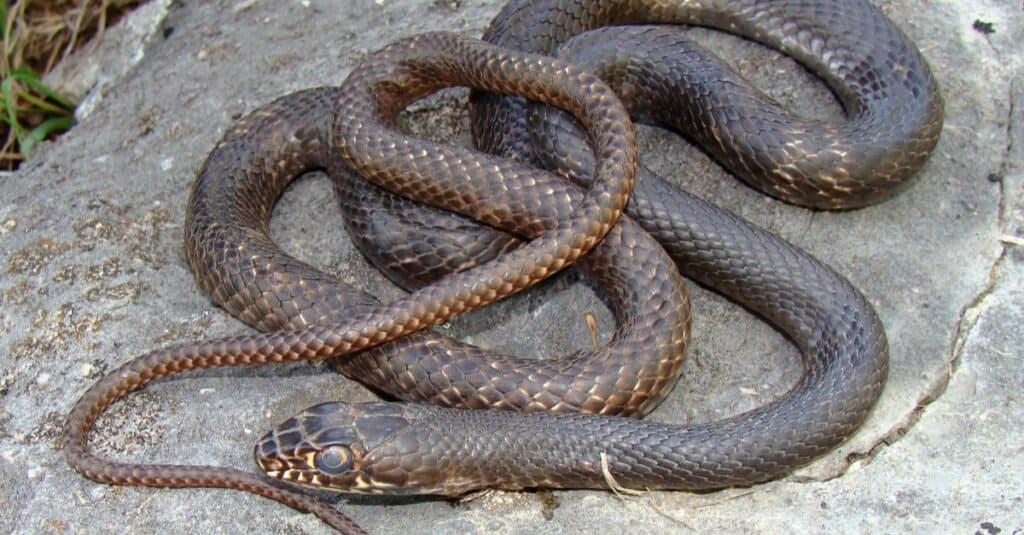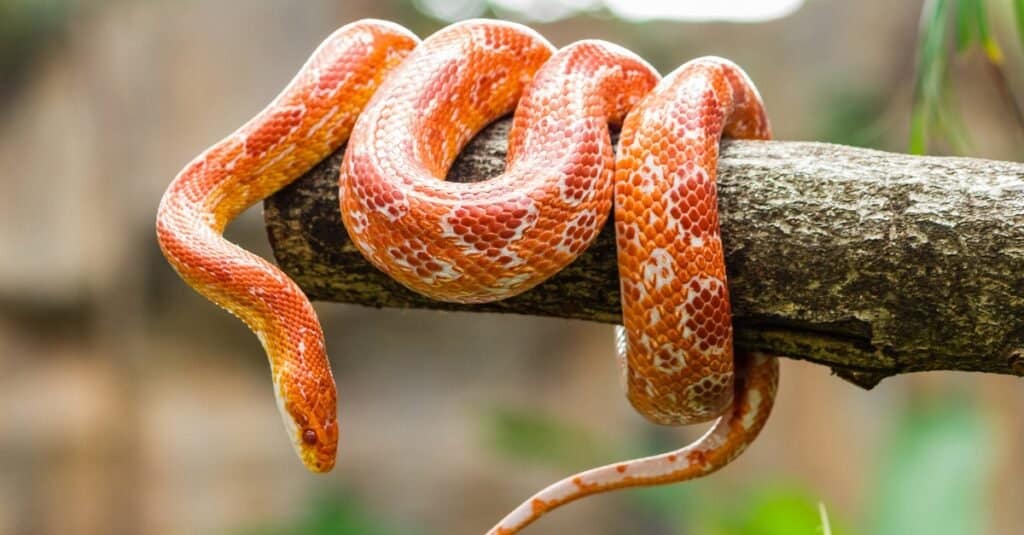Do snakes eat birds? The simple answer is yes, although most snake types will not be able to capture an adult bird. Instead, the consumption of birds is more of an opportunistic kill. There are four snakes worth noting that eat birds.
Snakes eating eggs and chicks is often the number one cause of nest failure with birds. When that is compared to the fact that only half of the bird’s nests are successful, it implies that a lot of birds are eaten by snakes. Most nest failures are caused by predation.
That isn’t to say that some snakes choose birds as their major food source. Bird eggs and bird chicks, on the other hand, can be a common food source for a lot of snakes. If a snake is going to raid a nest, it usually does so at night.
We know that birds of prey can eat snakes, but what snakes can eat birds? Here we’ll discuss four of the snakes on the planet that eat birds. First, a picture preview:

Now read on for more information about these snakes and their feathery prey!
Coachwhips

Coachwhip snakes like to eat birds and bird eggs.
©Matt Jeppson/Shutterstock.com
Coachwhip snakes can reach eight feet in length and are slender. They’re called coachwhips because of the crosshatched scale pattern that resembles an old horsewhip. They are mostly found in the southern part of the United States, and they come in a variety of colors that are found in nature.
Coachwhips are nonvenomous, and they love to dine on birds and bird eggs. They catch birds through the element of surprise and use their speed to snag their meal.
While coachwhip snakes love a good bird, they also eat amphibians, rodents, lizards, and other snakes. When on the hunt for food, they keep their heads held high to see well.
Kingsnakes

Kingsnakes have a diet that includes birds and other snakes.
©Creeping Things/Shutterstock.com
Kingsnakes are a common occurrence in most of the United States. They’re nonvenomous, use constriction, and they grow up to five feet long. On top of a diet with birds in it, kingsnakes also eat lizards and other snakes.
Since they often make a dinner out of venomous snakes, it’s believed that they are immune to the toxicity. There are several kingsnakes found in North America, and all of them are nest robbers.
Like a lot of nonvenomous snakes, kingsnakes swallow bird eggs whole without cracking them. They can’t chew; they can only use their teeth to direct food down the throat.
Rat Snakes
Rat snakes are found all over America. While they’re active during the day, they do most of their predation at night. They’re nonvenomous, and as their name implies, they eat mostly rats though they make a meal of birds too.
Rat snakes find these nests by methodically watching the movement of mothers from their nests to get a sense of location. During the night, when the mother is gone, the snakes climb the trees and eat the undefended contents.
Rat snakes are notorious bird nest raiders. They prefer to snack on the nest’s contents when the birds are babies rather than when they’re eggs. They constrict prey that needs subduing since they are nonvenomous.
If the rat snake is found out while nest content consumption occurs, birds are less likely to attack at night than they are during the day.
Corn Snakes

Corn snakes are great climbers, making them able to prey on birds.
©iStock.com/bugphai
Corn snakes are exceptionally pretty, and they’re adept hunters. They’re also just one of many types of rat snakes in existence. They’re great climbers, and they eat both birds and eggs. They live up to eight years in nature and over two decades in captivity.
Corn snakes grow up to six feet, making it easy for them to eat unaware birds and the contents of their nests. Snakes account for a little over a third of all nest raids, with corn snakes and other rat snakes being the primary culprit. They’re the predator in over 70% of nest-raiding situations.
Pit Vipers
Pit vipers are called such because they have heat-sensing pits on either side of their face to detect warm-blooded prey. They strike, let the prey die, and then follow its scent until it is located. They’re highly venomous snakes that wreak havoc on humans.
There are various kinds found throughout Asia and America. The rattlesnake and the copperhead are two famous ones that live in the United States. There are over 150 different kinds of pit vipers found around the world.
Rattlesnakes

Rattlesnakes and roadrunners eat each other.
©Alexandree/Shutterstock.com
Rattlesnakes are known to eat roadrunners in the American Southwest, though this predation goes both ways, and roadrunners will eat rattlesnakes. Roadrunners are quick, and although they aren’t immune to snake venom, they still seek out rattlesnakes as one main food source.
Diamondback rattlesnakes are known to eat doves and quails as well. What really makes a rattlesnake unique from other pit vipers isn’t the tail shaking; it’s the keratin rattle at the tip of its tail that clanks together when shaken. Keratin is the same protein that human nails are made from.
The diamondback rattlesnake uses squirrels to its advantage when hunting birds that it wants to ambush within striking distance. The squirrels get upset at the snake’s presence and kick dirt all over it. The snake continues to sit there until it’s buried, providing even better camouflage against birds.
Birds that the diamondback hunts can get away at about the same speed as the rattlesnake’s strike, so it has to be taken by surprise.
Shedao Pit Vipers
The Shedao pit viper, found only on an island in China, has been observed to actively go after live adult birds while in trees.
Shedao pit vipers grow to be a little over two feet in length, yet they take quite sizeable prey. They evolved to feed primarily on birds during the fall and spring and go through a period of sluggishness at other times to deal with the lack of a regular food source.
Summary of 4 Snakes That Eat Birds
| Name of Snake | Hunting Method |
|---|---|
| Pit Viper: Example snake — Rattlesnake Shedao Pit Viper | Pit Vipers use their heat-sensing pits to detect warm-blooded prey, then strike, let the prey die, and find it by smell. Rattlesnakes use camouflage and the element of surprise. Shedaos actively hunt in trees. |
| Rat Snake: Example snake — Corn Snake | Rat snakes raid nests when the mother bird is gone; they eat baby birds but not eggs; use constriction to kill since they are not venomous. Corn snakes are great climbers that use their length to reach nests; will eat baby birds and eggs. |
| Kingsnake | Kingsnakes use constriction to kill birds. They swallow bird eggs whole because they can’t chew; they can only use their teeth to direct food down the throat. |
| Coachwhip | Coachwhips are nonvenomous and catch birds through the surprise of their speed; they also eat bird eggs. |
The photo featured at the top of this post is © Matt Jeppson/Shutterstock.com
Discover the "Monster" Snake 5X Bigger than an Anaconda
Every day A-Z Animals sends out some of the most incredible facts in the world from our free newsletter. Want to discover the 10 most beautiful snakes in the world, a "snake island" where you're never more than 3 feet from danger, or a "monster" snake 5X larger than an anaconda? Then sign up right now and you'll start receiving our daily newsletter absolutely free.
Thank you for reading! Have some feedback for us? Contact the AZ Animals editorial team.






